牛津小学英语 4B Unit 4 Buying fruit
- 格式:doc
- 大小:246.50 KB
- 文档页数:5

《牛津小学英语》4BUnit4Buyingfruit
四年级英语教案
●一、教学目标
1. 能听懂、会说、会读和会写句型what are these/those?
they’re ….how many kilos? …kilos, please.2. 能听懂、会说、会读和会写
单词grapes.
●二、教具准备
1、课前在教室四周贴上水果图片,将全班分成6个小组。
2、超市小货架,
营业员佩带的胸卡、单词、句型卡片、喇叭、帽子、各种水果实物。
●三、设计思路
围绕“听说读写能力的培养”这一主题,通过深入浅出的句型操练,让学生
在掌握句型的基础上主动参与购物、自主训练,最终达到把所学知识转化为实际
应用能力的目的。
●三、教学过程
step 1 say a rhyme《they are all play》 pears, bananas and
pineapple. oranges, peaches and apples. big fruit and small fruit, they are all very good.(设计意图。
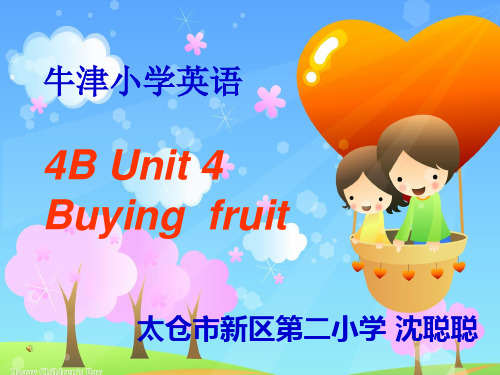
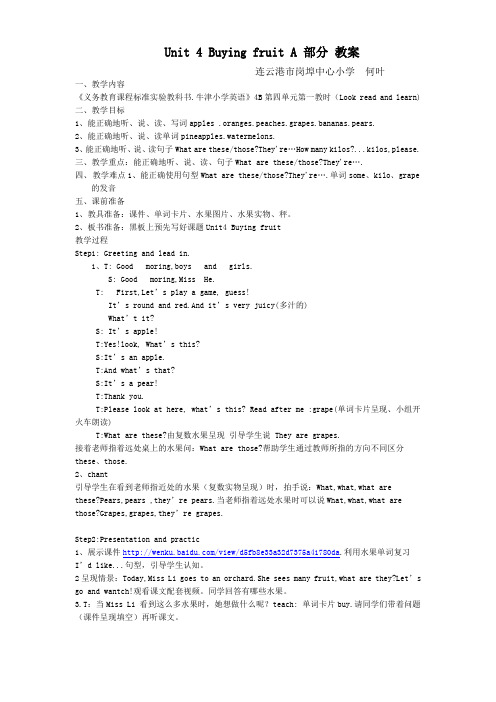
Unit 4 Buying fruit A 部分教案连云港市岗埠中心小学何叶一、教学内容《义务教育课程标准实验教科书.牛津小学英语》4B第四单元第一教时(Look read and learn)二、教学目标1、能正确地听、说、读、写词apples .oranges.peaches.grapes.bananas.pears.2、能正确地听、说、读单词pineapples.watermelons.3、能正确地听、说、读句子What are these/those?They're…How many kilos?...kilos,please.三、教学重点:能正确地听、说、读、句子What are these/those?They're….四、教学难点1、能正确使用句型What are these/those?They're….单词some、kilo、grape的发音五、课前准备1、教具准备:课件、单词卡片、水果图片、水果实物、秤。
2、板书准备:黑板上预先写好课题Unit4 Buying fruit教学过程Step1: Greeting and lead in.1、T: Good moring,boys and girls.S: Good moring,Miss He.T: First,Let’s play a game, guess!It’s round and red.And it’s very juicy(多汁的)What’t it?S: It’s apple!T:Yes!look, What’s this?S:It’s an apple.T:And what’s that?S:It’s a pear!T:Thank you.T:Please look at here, what’s this? Read after me :grape(单词卡片呈现、小组开火车朗读)T:What are these?由复数水果呈现引导学生说 They are grapes.接着老师指着远处桌上的水果问:What are those?帮助学生通过教师所指的方向不同区分these、those.2、chant引导学生在看到老师指近处的水果(复数实物呈现)时,拍手说:What,what,what are these?Pears,pears ,they’re pears.当老师指着远处水果时可以说What,what,what are those?Grapes,grapes,they’re grapes.Step2:Presentation and practic1、展示课件/view/d5fb8e33a32d7375a41780da.利用水果单词复习I’d like...句型,引导学生认知。
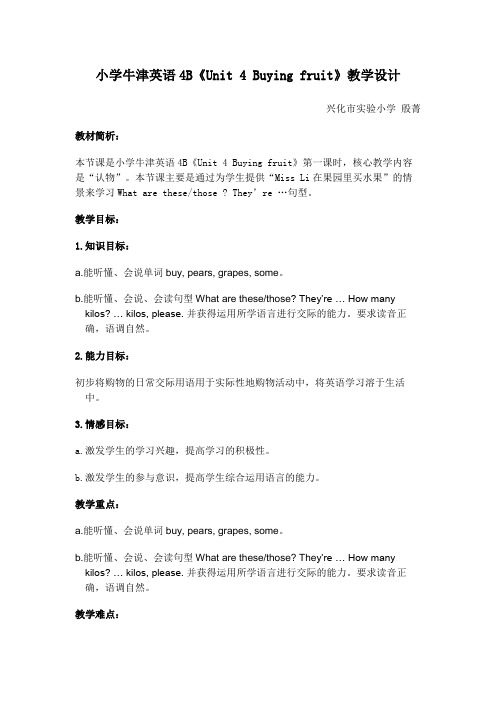
小学牛津英语4B《Unit 4 Buying fruit》教学设计兴化市实验小学殷菁教材简析:本节课是小学牛津英语4B《Unit 4 Buying fruit》第一课时,核心教学内容是“认物”。
本节课主要是通过为学生提供“Miss Li在果园里买水果”的情景来学习What are these/those ? They’re …句型。
教学目标:1.知识目标:a.能听懂、会说单词buy, pears, grapes, some。
b.能听懂、会说、会读句型What are these/those? They’re … How many kilos? … kilos, please. 并获得运用所学语言进行交际的能力。
要求读音正确,语调自然。
2.能力目标:初步将购物的日常交际用语用于实际性地购物活动中,将英语学习溶于生活中。
3.情感目标:a.激发学生的学习兴趣,提高学习的积极性。
b.激发学生的参与意识,提高学生综合运用语言的能力。
教学重点:a.能听懂、会说单词buy, pears, grapes, some。
b.能听懂、会说、会读句型What are these/those? The y’re … How many kilos? … kilos, please. 并获得运用所学语言进行交际的能力。
要求读音正确,语调自然。
教学难点:a.能听懂、会说、会读句型What are these/those? They’re … How many kilos? … kilos, please. 并获得运用所学语言进行交际的能力。
要求读音正确,语调自然。
b. 初步将购物的日常交际用语用于实际性地购物活动中,将英语学习溶于生活中。
设计理念:新课程标准要求教师应该是学生的培养者,引路人。
教师应努力为学生营造良好的学习氛围,创设真实的语言情景,增强趣味性,让学生们学会运用所学语言,勇于开口,敢于开口,乐于开口,从而达到教学的目的。
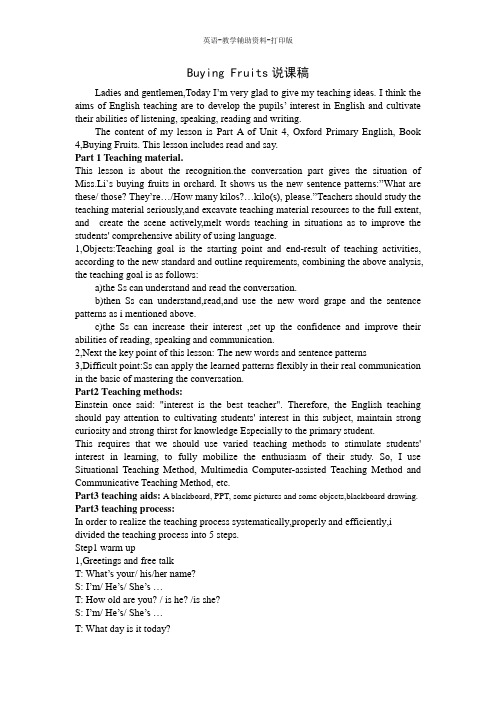
Buying Fruits说课稿Ladies and gentlemen,Today I’m very glad to give my teaching ideas. I think the aims of English teaching are to develop the pupils’ interest in English and cultivate their abilities of listening, speaking, reading and writing.The content of my lesson is Part A of Unit 4, Oxford Primary English, Book 4,Buying Fruits. This lesson includes read and say.Part 1 Teaching material.This lesson is about the recognition.the conversation part gives the situation of Miss.Li`s buying fruits in orc hard. It shows us the new sentence patterns:”What are these/ those? They’re…/How many kilos?…kilo(s), please.”Teachers should study the teaching material seriously,and excavate teaching material resources to the full extent, and create the scene actively,melt words teaching in situations as to improve the students' comprehensive ability of using language.1,Objects:Teaching goal is the starting point and end-result of teaching activities, according to the new standard and outline requirements, combining the above analysis, the teaching goal is as follows:a)the Ss can understand and read the conversation.b)then Ss can understand,read,and use the new word grape and the sentence patterns as i mentioned above.c)the Ss can increase their interest ,set up the confidence and improve their abilities of reading, speaking and communication.2,Next the key point of this lesson: The new words and sentence patterns3,Difficult point:Ss can apply the learned patterns flexibly in their real communication in the basic of mastering the conversation.Part2 Teaching methods:Einstein once said: "interest is the best teacher". Therefore, the English teaching should pay attention to cultivating students' interest in this subject, maintain strong curiosity and strong thirst for knowledge Especially to the primary student.This requires that we should use varied teaching methods to stimulate students' interest in learning, to fully mobilize the enthusiasm of their study. So, I use Situational Teaching Method, Multimedia Computer-assisted Teaching Method and Communicative Teaching Method, etc.Part3 teaching aids:A blackboard, PPT, some pictures and some objects,blackboard drawing. Part3 teaching process:In order to realize the teaching process systematically,properly and efficiently,i divided the teaching process into 5 steps.Step1 warm up1,Greetings and free talkT: What’s your/ his/her name?S: I’m/ He’s/ She’s …T: How old are you? / is he? /is she?S: I’m/ He’s/ She’s …T: What day is it today?S: It’s …T: Wh at’s the weather like today?S:It’s …The greetings take the Ss into the atmosphere of learning English and concentrate their attention on the class.2,afterwards i will show some pictures of fruits on the PPT(apples pears oranges),then i will ask the Ss: what are they? Which fruit do you like? (write down the word “fruit”on the blackboard.)I lead the fruits out and then show the first two sentences.Step 2 presentation and practice1,I will take out some fruits which were covered by a cloth.T:since you are all like fruits, let`s go to the fruit shop, guess,what is that?(what are these?)S1:it`s.../they are...(S2,S3...)then i will show the fruits on the blackboard.T:what is that?(what are those?)S1:it`s.../they are...(S2,S3...)Let’s chant:These, these, what are these?Apples, apples, they are apples.Those, those, what are those?Grapes, grapes, they are grapes.(Boys read the former parts and girls the later parts.)Chant trips off the tongue mobilizes the classroom atmosphere, and consolidate the new sentence patterns,the boy and girl students read in consociation exercise their cooperation ability. )2,T:what would you like?Ss:i like apples.T: i like apples too, i`d like some apples,how many would you like?(write down the sentence patterns)Ss:one/two/three(S1,S2...)Say a chant:How many, how many, how many kilos?One kilo, two kilos, three kilos;Four kilos, five kilos, six kilos;Seven kilos, eight kilos, nine kilos;I’d like nine kilosSupposed that we are in the shop, the Ss will be wanted to play a role game. Situational Teaching Method stimulate the students' interest in learning and cultivate their English communication skills,and oral communication ability3,let`s open the book,look!who is she?what is she doing now?the Ss answer she is Miss Li,she is buying fruits,i will repeat: Miss Li is buying fruits, let`s go with her.OK?listen to the tape and answer the question(taped on the PPT)What fruit does Miss Li buy? They are some_grapes_and _pears_. I will ask the Ss to draw the answeras a picture on blackboard.then read the conversation after me,then answer me:how many kilos of pear/grape would Miss.Li like?Read it in roles. (Boys act as the farmer and girls act as Miss Li.)Read the dialogue in roles with your partners.Step 3 productionHelen is your friend,she is ill,you are going to visit her with some fruits,act it out. It can help the T and Ss to know how the Ss master the contest and how the Ss apply it to real situation.Step4 assignmentSummarize the whole lesson,and arrange the homework.Do the correlative exercises in the activity book.Step5 blackboard designShow on the CAI.(It’s a ….)Anyway, the teaching of this lesson aims to develop not only the Ss' language technical abilities, but also the diverse intelligence by integrated teaching methods.As teachers, to make our English classrooms shine with vitality, we are laid with heavy burden, and we still have long way to go.Above is the lecture notes of my lesson. Thank you!。
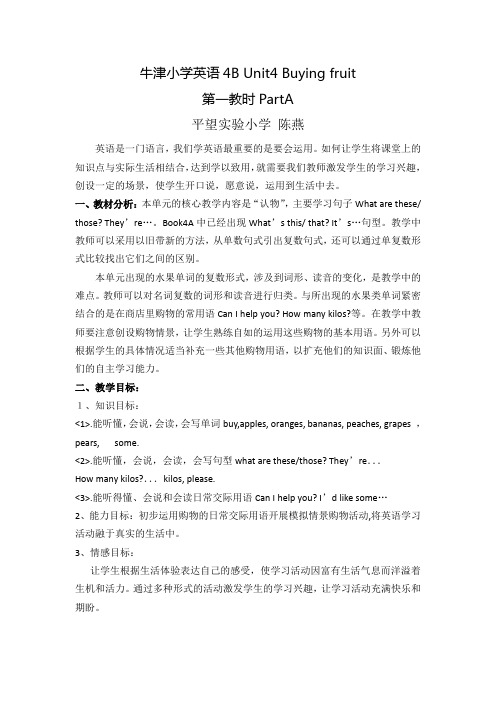
牛津小学英语4B Unit4 Buying fruit第一教时PartA平望实验小学陈燕英语是一门语言,我们学英语最重要的是要会运用。
如何让学生将课堂上的知识点与实际生活相结合,达到学以致用,就需要我们教师激发学生的学习兴趣,创设一定的场景,使学生开口说,愿意说,运用到生活中去。
一、教材分析:本单元的核心教学内容是“认物”,主要学习句子What are these/ those? They’re…。
Book4A中已经出现What’s this/ that? It’s…句型。
教学中教师可以采用以旧带新的方法,从单数句式引出复数句式,还可以通过单复数形式比较找出它们之间的区别。
本单元出现的水果单词的复数形式,涉及到词形、读音的变化,是教学中的难点。
教师可以对名词复数的词形和读音进行归类。
与所出现的水果类单词紧密结合的是在商店里购物的常用语Can I help you? How many kilos?等。
在教学中教师要注意创设购物情景,让学生熟练自如的运用这些购物的基本用语。
另外可以根据学生的具体情况适当补充一些其他购物用语,以扩充他们的知识面、锻炼他们的自主学习能力。
二、教学目标:1、知识目标:<1>.能听懂,会说,会读,会写单词buy,apples, oranges, bananas, peaches, grapes ,pears, some.<2>.能听懂,会说,会读,会写句型what are these/those? They’re...How many kilos?...kilos, please.<3>.能听得懂、会说和会读日常交际用语Can I help you? I’d like some…2、能力目标:初步运用购物的日常交际用语开展模拟情景购物活动,将英语学习活动融于真实的生活中。
3、情感目标:让学生根据生活体验表达自己的感受,使学习活动因富有生活气息而洋溢着生机和活力。
牛津小学英语 4B Unit 4 Buying fruit (第一课时)梅堰实验小学吴阿二 215225一、课题:《牛津小学英语》4B第四单元第一教时二、教材简解:《牛津小学英语》4B第四单元第一课时的教学内容。
本课的教学重点是学习有关的水果的单词及日常用语What are these? They’re … What are those? They’re …三、目标预设:(一)认知目标1、能听得懂、会说、会读单词apples, oranges, bananas, peaches, grapes, pears, watermelons, pineapples, mangoes.2、能听得懂、会说、会读日常交际用语What are these/those? They’re… How many kilos? …kilos, please.3、能有表情地诵读歌谣(二)能力目标1、教师用以旧带新的方法,从单数句式引出复数句式,让学生明白之间的区别。
2、通过卡片、实物、媒体演示,创设出一些语境来让学生体验语言的真实、自然及语言的交际功能。
3、通过设计多种教学活动,如歌谣、唱歌等,把书本知识融入活动中,在活动中不断地吸收、内化所学的语言材料。
(三)情感目标把语言训练融入各种情景及活动之中,努力营造一种愉快轻松的教学氛围,让学生充满乐趣地学习。
四、教学重难点:(一)重点1、四会单词apples, oranges, bananas, peaches, grapes与句型What are these? They’re …What are those? They’re …2、熟练灵活地在情景中运用日常用语What are these? They’re …What are those? They’re …(二)难点1、四会单词apples, oranges, bananas, peaches, grapes的拼写2、正确使用these与those,能区分出两者的远近关系。
五、设计理念:小学英语教学倡导活动式教学,其目的是让学生在不同的语言活动中感受,理解,记忆并运用语言,让学生在积极参与,大胆实践中达到学以致用的效果。
激发他们学习英语的兴趣,培养他们学习英语的积极态度,建立初步的学习英语的自信心,培养一定的语感和良好的语音,形成初步用英语进行简单日常交流的能力。
六、设计思路:1、本课的重点句型What are these/those? They’re …与4A中已学过的What’s this/that? It’s..句型类似,学生容易理解与接受,所以我采用了以旧带新的方法,将此点破。
但是学生对these与those的发音上有困难,因此,在教学过程中,我注重了这两个词读音教学。
2、四年级学生争强好胜的心理较强,为发挥这一优势,我用小旗夺星的竞赛活动,贯穿整个课堂教学活动,并采用说说、猜猜、演演等多样活动形式,充分调动学生的学习积极性。
3、在课文的对话教学中,我努力采用了情景教学法,营造学生购物的真实情景,促进学生理解和运用新知。
七、教学准备:1、课前在教室四周贴上水果图片,将全班分成4小组。
2、超市小货架、营业员证、单词和句型卡片、喇叭、若干水果等八、教学过程:Step 1 Warm up1.Sing a song: Apple trees.(设计意图:歌曲是学生喜闻乐见的课堂教学形式之一。
让学生边唱边做动作,有助于吸引学生的注意力,进入学习英语的状态,为接下来的学生做好准备,让他们全身心投入到学习活动中。
)2.Show the contest regulation.将全班分为四个小组:苹果组、梨子组、葡萄组、橘子组。
每个小组发一个红旗,答对一个问题就往小旗上贴一枚五角星,宣布完比赛规则,老师激励学生说:Which team will be the winner? Let’s wait and see!Team Team Team Team(设计意图:四年级学生争强好胜的心理较强,为发挥这一优势,我用小旗夺星的竞赛活动,贯穿整个课堂教学活动,并采用说说、猜猜、演演等多样活动形式,充分调动学生的学习积极性。
)Step 2 Presentation1.Touch and guessT:Let’s play a game. Look,this is a fruit. Guess, what’s this?(师手握一个苹果请学生猜猜)what’s that? Do you know?(师指着远处窗台上的水果问学生,水果用手帕盖着)show a bag with some fruit and say “t here are some fruit in my bag2.Do you know what’s that ? What are these?(请学生猜一猜,如果很难再请一位学生来摸一摸水果猜一猜)同时引出句子:What are these?They’r e …(设计意图:从触摸游戏入手,引出句型They’re …,可激起学生的好奇心和积极参与的欲望,同时将学生的注意力集中到水果复数上,同时达到句型what are these?早渗透、勤反复的目的。
)2. T:What are these? (出示单词图片)Ss: They’re…. (apples、oranges、pears、bananas、peaches)a.T: They’re grapes. (read and spell)Grapes, grapes. I’d like some grapes.(say the chant team by team) b.T:What are these? (拿着实物问学生)S: They’re grapes.c.T: 出示句型卡片:What are these? (整体认读整个句子,并拼读单词these)3.Ask and answer(利用学生所带水果进行操练)S1: Hello, S2, what are these?S2:They’re ….S3: Hello, S4, what are these?S4: They’re ….(……)(设计意图:用学生自带水果操练句型What are these? They’re…可联系学生生活实际,提高学生操练的积极性,同时,单词和句型的结合,可达到实际运用的目的)。
4.T: (手指教室墙上的水果图片)What are those?Ss: They’re…(引导学生正确回答)。
1)T: (出示句型卡片)What are those?Ss: 读句子,并拼读单词those。
2)Pair work and check: What are those? They’re ….5.T: Now, let’s play. Stand up and follow me.1)T:This, that, these, those.(边说边做动作)Ss: ……2)T:Now, listen and do.(老师说单词,学生做手势)。
3)Say together: This this this, that that that, these these these, those those those.(设计意图:学完两组句型之后,利用一个简单的听做活动, 既帮助学生理解了本堂课的难点“these”和“those”,又活跃了课堂气氛,使学生身心放松,缓和了紧张的学习气氛。
)Step 3: Learn and practice1. T: What are these/those?Ss: They’re….T: They are fruit. Do you like fruit?Ss: Yes, I do.T: Let’s go to the supermarket. OK?(老师戴上售货员帽子,拿出一只话筒,扮演水果店老板并拖长声调叫卖:Apples, apples, three yuan a kilo; Bananas, bananas, four yuan a kilo,同时将卡片three yuan a kilo;four yuan a kilo出示)。
(设计意图:教师将水果店摆进课堂,并扮演水果店老板,较好地创设了购物情境,使学生对kilo留下较为深刻的印象,同时为kilo的学习打下铺垫。
)2.T:(出示卡片)one kilo(学生练说one kilo, two kilos, three kilos…)T:One kilo and two kilos, how many kilos?Ss:……kilos. (学生看着卡片练说句式)。
(设计意图:用做数学加法题的方式引出并操练How many kilos?…kilos.学生容易理解接受,并使交际变得有意义。
)3. Ask and answer in groups.4.1)教师与学生示范购物过程。
T: Now ,boys and girls. Can I help you?S1: I’d like some …,please.T: How many kilos?S1: … kilos, please.T: Here you are.2)分组购物活动,并评出优胜小组。
(设计意图:教师与学生的购物活动,为学生创设了真实的操练情景、更自由的创造空间,提高了学生的参与欲,培养了学生的协作精神,充分发挥了他们的各项智能。
同时,比赛方式的开展又可以激发学生的好胜心,使学生的潜能尽情释放。
)Step 4 Consolidation1.Listen and read “Part A”.2.Read in pairs.3.Read the new words and sentences in this lesson.4.Learn to sing a song.(歌唱配以“两只老虎”的音乐)What are these? What are those? They’re grapes, they’re grapes.How many kilos? How many kilos?Three kilos, please. Three kilos, please.(设计意图:以唱歌的形式将本堂课所学内容作一小结,在欢快的气氛中巩固知识。
)5.表扬哪个小队得的五角星多。
Step 5 Homework(给出一个“Magic box”,让学生任选一个,其中的作业作为自己的家庭作业)1. Copy the words four times.2. Make a new dialogue about shopping with your partner.3. Go to the supermarket with your friend ,then make a dialogue. (设计意图:通过设计不同层次的作业,让学习能力处于不同层次的学生自主挑选一个作业来完成,以达到分层巩固的目的。